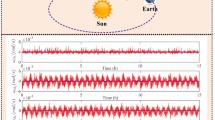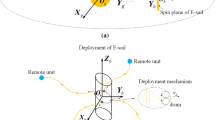Abstract
In this study, the effects of solar wind on an electric sail (E-sail) are modeled and analyzed using an absolute nodal coordinate formulation (ANCF). First, the thrust of the charged metal tether that makes up the E-sail was analyzed and a model was established. Numerical simulations of a single metal tether were performed. Then, an overall E-sail model was established using the connection matrix, and E-sails subjected to different angular velocities were compared. Simulation results of the ANCF model and a dumbbell model were compared at different angular velocities. The results confirm that with a relatively high angular velocity, the flexible metal chain can be approximately regarded as a rigid body. However, with a small angular velocity, the flexibility of the metal chain cannot be ignored.
Similar content being viewed by others
Change history
11 February 2022
A Correction to this paper has been published: https://doi.org/10.1007/s42064-022-0136-2
References
Janhunen, P. Electric sail for spacecraft propulsion. Journal of Propulsion and Power, 2004, 20(4): 763–764.
Janhunen, P. On the feasibility of a negative polarity electric sail. Annales Geophysicae, 2009, 27(4): 1439–1447.
Janhunen, P. Increased electric sail thrust through removal of trapped shielding electrons by orbit chaotisation due to spacecraft body. Annales Geophysicae, 2009, 27(8): 3089–3100.
Janhunen, P. Electrostatic plasma brake for deorbiting asatellite. Journal of Propulsion and Power, 2010, 26(2): 370–372.
Janhunen, P. The electric sail: A new propulsion method which may enable fast missions to the outer solar system. Journal of British Interplanetary Society, 2008, 61(8): 322–325.
Huo, M. Y., Mengali, G., Quarta, A. A. Optimal planetary rendezvous with an electric sail. Aircraft Engineering and Aerospace Technology, 2016, 88(4): 515–522.
Janhunen, P., Lebreton, J. P., Merikallio, S., Paton, M., Mengali, G., Quarta, A. A. Fast E-sail Uranus entry probe mission. Planetary and Space Science, 2014, 104: 141–146.
Janhunen, P., Toivanen, P., Envall, J., Merikallio, S., Montesanti, G., del Amo, J., Kvell, U., Noorma, M., Latt, S. Overview of electric solar wind sail applications. Proceedings of the Estonian Academy of Sciences, 2014, 63(2S): 267.
Janhunen P. The electric solar wind sail status report. In: Proceedings of European Planetary Science Congress, 2010, 2010: 291–297.
Mengali, G., Quarta, A. A., Aliasi, G. A graphical approach to electric sail mission design with radial thrust. Acta Astronautica, 2013, 82(2): 197–208.
Toivanen, P. K., Janhunen, P. Spin plane control and thrust vectoring of electric solar wind sail. Journal of Propulsion and Power, 2013, 29(1): 178–185.
Mengali, G., Quarta, A. A., Aliasi, G. A graphical approach to electric sail mission design with radial thrust. Acta Astronautica, 2013, 82(2): 197–208.
Mengali, G., Quarta, A. A. Escape from elliptic orbit using constant radial thrust. Journal of Guidance, Control, and Dynamics, 2009, 32(3): 1018–1022.
Janhunen, P., Sandroos, A. Simulation study of solar wind pushonachargedwire: Basis of solar wind electric sail propulsion. Annales Geophysicae, 2007, 25(3): 755–767.
Mengali, G., Quarta, A. A., Janhunen, P. Electric sail performance analysis. Journal of Spacecraft and Rockets, 2008, 45(1): 122–129.
Liu, F., Hu, Q., Liu, Y. F. Attitude dynamics of electric sail from multibody perspective. Journal of Guidance, Control, and Dynamics, 2018, 41(12): 2633–2646.
Tsuda, Y., Ono, G., Mimasu, Y. Classification of solar sail attitude dynamics with and without angular momentum. Astrodynamics, 2019, 3(3): 207–216.
Caruso, A., Quarta, A. A., Mengali, G. Comparison between direct and indirect approach to solar sail circle-to-circle orbit raising optimization. Astrodynamics, 2019, 3(3): 273–284.
Heiligers, J., Fernandez, J. M., Stohlman, O. R., Wilkie, W. K. Trajectory design for a solar-sail mission to asteroid 2016 HO3. Astrodynamics, 2019, 3(3): 231–246.
Quarta, A. A., Mengali, G., Bassetto, M. Optimal solar sail transfers to circular Earth-synchronous displaced orbits. Astrodynamics, 2019, DOI: https://doi.org/10.1007/s42064-019-0057-x.
Takao, Y., Mori, O., Kawaguchi, J. Self-excited oscillation of spinning solar sails utilizing solar radiation pressure. Astrodynamics, 2019, DOI: https://doi.org/10.1007/s42064-018-0047-4.
Zhang, Y., Wei, C., Zhao, Y., Tan, C. Xu, D. Dynamic modeling and simulation of loose rope based on ANCF., Acta Aeronautica et Astronautica Sinica, 2017, 38(04): 220586–220586.
Zhang, J. Research on attitude-vibration coupled modeling and fault-tolerant control of flexible solar sail spacecraft. Ph.D. Dissertation. Nanjing, China: Nanjing University of Aeronautics and Astronautics, 2019.
Koh, C. G., Rong, Y. Dynamic analysis of large displacement cable motion with experimental verification. Journal of Sound and Vibration, 2004, 272(1–2): 187–206.
Shabana, A. A. Computational Continuum Mechanics. Cambridge: Cambridge University Press, 2008.
Hu, X. S., Gong, S. P. Flexibility influence on passive stability of a spinning solar sail. Aerospace Science and Technology, 2016, 58: 60–70.
Huo, M., Zhao, J., Xie, S., Qi, N. Coupled attitude-orbital dynamics and control for an e-sail in a heliocentric transfer mission. PLoS One, 2015, 10(5): e0125901.
Chen, M. L., Xia, G. Q., Wei, Y. M., Yu, Y., Sun, A. B., Mao, G. W. Charateristics and stress analysis of sheath of parallel conducting tethers for the electric sail. Acta Physica Sinica, 2016, 65(20): 283–293. (in Chinese)
Gong, S. P., Baoyin, H. X., Li, J. F. Solar sail formation flying around displaced solar orbits. Journal of Guidance, Control, and Dynamics, 2007, 30(4): 1148–1152.
Gong, S. P., Baoyin, H. X., Li, J. F. Relative orbit design and control of formation around displaced solar orbits. Aerospace Science and Technology, 2008, 12(2): 195–201.
Janhunen, P. Increased electric sail thrust through removal of trapped shielding electrons by orbit chaotisation due to spacecraft body. Annales Geophysicae, 2009, 27(8): 3089–3100.
Arnold, M., Brüls, O. Convergence of the generalized-α scheme for constrained mechanical systems. Multibody System Dynamics, 2007, 18(2): 185–202.
Acknowledgements
This work was supported, in part, by the National Natural Science Foundation of China (NSFC, Nos. 11672093, U1737207, and 11702072). It was also supported by the China Postdoctoral Science Foundation under Grant No. 2017M611372, and by the Heilongjiang Postdoctoral Fund under Grant No. LBH-Z16082.
Author information
Authors and Affiliations
Corresponding author
Additional information
Ce Zhao received his B.S. degree of engineering from Harbin Institute of Technology, China, in 2019. Currently, he is a postgraduate student of Harbin Institute of Technology. His current research interests are dynamics and orbit control of electric (E)-sail.
Mingying Huo received his Ph.D. degree in aeronautical and astronautical science and technology from the Harbin Institute of Technology, Harbin, China, in 2015. He is currently a research assistant in the Department of Aerospace Engineering, Harbin Institute of Technology. His research interests mainly include dynamics and control of electric solar wind sail, and shape-based trajectory optimization method.
Ji Qi received his B.Eng. degree in electrical engineering and automation from Harbin Engineering University, Harbin, China, in 2017. He is currently pursuing his M.S. degree in Ming Hsieh Department of Electrical and Computer Engineering, University of Southern California, USA. His current research interests include modern semiconductor devices, high performance digital integrated circuit design, and machine learning.
Shilei Cao received his B.S. degree in aerospace engineering from Harbin Institute of Technology, Harbin, China, in 2015, where he is currently working toward his Ph.D. degree in the School of Astronautics. His current research interests include electric solar wind sail and flexible space structures.
Dongfang Zhu received his Ph.D. degree in control science and engineering from Harbin Institute of Technology, Harbin, China, in 2011. He is currently a senior engineer, Shanghai Aerospace Control Technology Institute, China. His research interests mainly include dynamics and control of complex spacecraft.
Lujun Sun received his master degree in machatronics engineering from Harbin Institute of Technology, Harbin, China, in 2013. He is currently a researcher in Department of Research and Development Center, Shanghai Aerospace Control Technology Institute, China. His interests mainly include nonlinear dynamics of periodic structures.
Hongli Sun received her Ph.D. degree from Nanjing University of Aeronautics and Astronautics, China, in 2011. Her research interests mainly include multibody system dynamics.
Naiming Qi received his Ph.D. degree in precision instrument and machinery from the Harbin Institute of Technology, Harbin, China, in 2001. He is currently a professor at the Department of Aerospace Engineering, Harbin Institute of Technology. His research interests mainly include dynamics and control of spacecraft, and trajectory optimization method.
Rights and permissions
About this article
Cite this article
Zhao, C., Huo, M., Qi, J. et al. Coupled attitude-vibration analysis of an E-sail using absolute nodal coordinate formulation. Astrodyn 4, 249–263 (2020). https://doi.org/10.1007/s42064-020-0081-x
Received:
Accepted:
Published:
Issue Date:
DOI: https://doi.org/10.1007/s42064-020-0081-x




